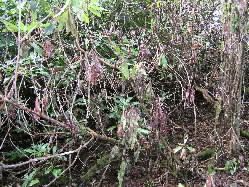 Rhododendron ponticum is a highly invasive species affecting woodland in the UK. It is also a host to two particularly significant diseases affecting our woodlands – Phytophthora ramorum and Phytophthora kernoviae. To control their spread, the eradication of rhododendron, usually by cutting and removal, is an accepted management practice. The regrowth of shoots on rhododendron stumps is however a common. The following two papers explore different aspects of this problem.
Rhododendron ponticum is a highly invasive species affecting woodland in the UK. It is also a host to two particularly significant diseases affecting our woodlands – Phytophthora ramorum and Phytophthora kernoviae. To control their spread, the eradication of rhododendron, usually by cutting and removal, is an accepted management practice. The regrowth of shoots on rhododendron stumps is however a common. The following two papers explore different aspects of this problem.
Synthetic herbicides were more effective than a bioherbicide based on Chondrostereum purpureum in reducing resprouting of Rhododendron ponticum, a host of Phytophthora ramorum in the UK
This paper reports on an experiment at a woodland site in south-west England to compare the effectiveness of a range of chemical herbicides and a fungal biocontrol application (Chondrostereum purpureum) in preventing resprouting of Rhododendron ponticum. The treatments were applied to cut rhododendron stumps in the summer and winter, and regrowth was assessed 25 months after their application. All chemical herbicide treatments were found to significantly reduce regrowth of shoots, and would therefore help to lower reinfection by Phytophthora. The fungal biocontrol treatment did not have a significant effect on the regrowth of shoots. The paper explains it may be that the fungal biocontrol treatment becomes effective over a longer period of time, also that its performance might be improved if there were a refinement of the application technique, and/or the preparation method and/or the selection of the particular group or ‘strain’ of fungus used.
Willoughby, I.H., Seier, M.K., Stokes, V.J., Thomas, S.E., Varia, S. (2015). Synthetic herbicides were more effective than a bioherbicide based on Chondrostereum purpureum in reducing resprouting of Rhododendron ponticum, a host of Phytophthora ramorum in the UK. Forestry 88 (3), 336-344.
Mixture B New Formulation adjuvant increases the rainfastness and hence effectiveness of glyphosate for rhododendron control
The control of rhododendron can be difficult and this is partly due to its thick waxy leaf surfaces, which discourage the absorption of herbicides when they are applied to the leaves. Chemical additives (called ‘adjuvants’) are widely used to improve the effectiveness of herbicides. In forestry, an application called ‘Mixture B’ has been used for many years to improve the absorption of herbicides based on the chemical glyphosate used to control rhododendron. The application works by helping prevent the herbicide being washed off the leaves when it rains and therefore encourages the absorption of the herbicide. The makeup of Mixture B has recently changed, and the new product called ‘Mixture B NF’, has not been independently tested for its effectiveness. An experiment was therefore carried out to test the effect of adding one of three adjuvant products (Mixture B, Mixture B NF and Break-ThruS240) to two example glyphosate based herbicides and to one triclopyr based herbicide, on the control of rhododendron plants. Treatments were sprayed on to the leaves of the rhododendron and then artificial rainfall was applied to them. Rainfall was not found to have any effect on the triclopyr based herbicide, which performed well with or without any of the adjuvants. The efficiency of both glyphosate based herbicides was reduced if there was rainfall after they had been applied but the resistance of both products to rainfall was substantially increased by the use of Mixture B and Mixture B NF. The adjuvant Break-ThruS240 gave little benefit.
Willoughby, I.H. and Stokes, V.J. (2015). Mixture B New Formulation adjuvant increases the rainfastness and hence effectiveness of glyphosate for rhododendron control. Forestry, 88 (2), 172-179.
